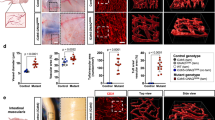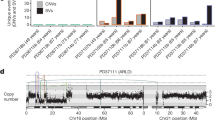Abstract
The close relationship between activation of blood coagulation and cancer is an old enigma. In 1865, migrans trombophlebitis (‘a condition of the blood that predisposes it to spontaneous coagulation’) was described as a forewarning of occult malignancy (Trousseau's sign1). This pioneering observation emphasized the existence of haemostasis disorders associated with cancer onset; this phenomenon has since been extensively reported in clinical and epidemiological studies2,3,4, but has so far resisted a mechanistic explanation. Here we report a mouse model of sporadic tumorigenesis based on genetic manipulation of somatic cells. Targeting the activated, human MET oncogene to adult liver caused slowly progressing hepatocarcinogenesis. This was preceded and accompanied by a syndrome manifesting first with blood hypercoagulation (venous thromboses), and then evolving towards fatal internal haemorrhages. The pathogenesis of this syndrome is driven by the transcriptional response to the oncogene, including prominent upregulation of plasminogen activator inhibitor type 1 (PAI-1) and cyclooxygenase-2 (COX-2) genes. In vivo analysis showed that both proteins support the thrombohaemorrhagic phenotype, thus providing direct genetic evidence for the long-sought-after link between oncogene activation and haemostasis.
This is a preview of subscription content, access via your institution
Access options
Subscribe to this journal
Receive 51 print issues and online access
$199.00 per year
only $3.90 per issue
Buy this article
- Purchase on Springer Link
- Instant access to full article PDF
Prices may be subject to local taxes which are calculated during checkout




Similar content being viewed by others
References
Trousseau, A. Phlegmasia alba dolens. Clinique Médicale de l'Hotel-Dieu de Paris Vol. 3, 654–712 (J. B. Ballière et Fils, Paris, 1865)
Baron, J. A., Gridley, G., Weiderpass, E., Nyrén, O. & Linet, M. Venous thromboembolism and cancer. Lancet 351, 1077–1080 (1998)
Rickles, F. R. & Levine, M. N. Epidemiology of thrombosis in cancer. Acta Haematol. 106, 6–12 (2001)
Lee, A. Y. Y. & Levine, M. N. Venous thromboembolism and cancer: risks and outcomes. Circulation 107 (suppl.), I17–I21 (2003)
Vigna, E. & Naldini, L. Lentiviral vectors: excellent tools for experimental gene transfer and promising candidates for gene therapy. J. Gene Med. 2, 308–316 (2000)
Trusolino, L. & Comoglio, P. M. Scatter-factor and semaphorin receptors: cell signalling for invasive growth. Nature Rev. Cancer 2, 289–300 (2002)
Schmidt, L. et al. Germline and somatic mutations in the tyrosine kinase domain of the MET proto-oncogene in papillary renal carcinomas. Nature Genet. 16, 68–73 (1997)
Di Renzo, M. F. et al. Expression of the Met/HGF receptor in normal and neoplastic human tissues. Oncogene 6, 1997–2003 (1991)
Pennacchietti, S. et al. Hypoxia promotes invasive growth by transcriptional activation of the met protooncogene. Cancer Cell 3, 347–361 (2003)
Park, M. et al. Mechanism of met oncogene activation. Cell 45, 895–904 (1986)
Dull, T. et al. A third-generation lentivirus vector with a conditional packaging system. J. Virol. 72, 8463–8471 (1998)
Follenzi, A., Sabatino, G., Lombardo, A., Boccaccio, C. & Naldini, L. Efficient gene delivery and targeted expression to hepatocytes in vivo by improved lentiviral vectors. Hum. Gene Ther. 13, 243–260 (2002)
Ponder, K. P. et al. Mouse hepatocytes migrate to liver parenchyma and function indefinitely after intrasplenic transplantation. Proc. Natl Acad. Sci. USA 88, 1217–1221 (1991)
Pfeifer, A. et al. Transduction of liver cells by lentiviral vectors: analysis in living animals by fluorescence imaging. Mol. Ther. 3, 319–322 (2001)
Rickles, F. R., Levine, M. N. & Dvorak, H. B. in Hemostasis and Thrombosis (eds Colman, R. W., Hirsh, J., Marder, V. J., Clowes, A. & George, J. N.) 1132–1152 (Lippincott Williams & Wilkins, Philadelphia, 2000)
Muller-Berghaus, G., ten Cate, H. & Levi, M. Disseminated intravascular coagulation: clinical spectrum and established as well as new diagnostic approaches. Thromb. Haemost. 82, 706–712 (1999)
Collen, D. The plasminogen (fibrinolytic) system. Thromb. Haemost. 82, 259–270 (1999)
Smith, W. L., De Witt, D. L. & Garavito, R. M. Cyclooxygenases: structural, cellular, and molecular biology. Annu. Rev. Biochem. 69, 145–182 (2000)
Friederich, P. W. et al. Novel low-molecular-weight inhibitor of PAI-1 (XR5118) promotes endogenous fibrinolysis and reduces postthrombolysis thrombus growth in rabbits. Circulation 96, 916–921 (1997)
Gupta, R. A. & DuBois, R. N. Colorectal cancer prevention and treatment by inhibition of cyclooxygenase-2. Nature Rev. Cancer 1, 13–20 (2001)
Dvorak, H. F. Tumors: wounds that do not heal. N. Engl. J. Med. 315, 1650–1659 (1986)
Zeng, Q., McCauley, L. K. & Wang, C. Y. Hepatocyte growth factor inhibits anoikis by induction of activator protein 1-dependent cyclooxygenase-2. Implication in head and neck squamous cell carcinoma progression. J. Biol. Chem. 277, 50137–50142 (2002)
FitzGerald, G. A. COX-2 and beyond: Approaches to prostaglandin inhibition in human disease. Nature Rev. Drug Discov. 2, 879–890 (2003)
Sidenius, N. & Blasi, F. The urokinase plasminogen activator system in cancer: recent advances and implication for prognosis and therapy. Cancer Metastasis Rev. 22, 205–222 (2003)
Nakamura, T. et al. Molecular cloning and expression of human hepatocyte growth factor. Nature 342, 440–443 (1989)
Trusolino, L., Pugliese, L. & Comoglio, P. M. Interactions between scatter factors and their receptors: hints for therapeutic applications. FASEB J. 12, 1267–1280 (1998)
Follenzi, A., Ailles, L. E., Bakovic, S., Geuna, M. & Naldini, L. Gene transfer by lentiviral vectors is limited by nuclear translocation and rescued by HIV-1 pol sequences. Nature Genet. 25, 217–222 (2000)
Medico, E. et al. The tyrosine kinase receptors Ron and Sea control “scattering” and morphogenesis of liver progenitor cells in vitro . Mol. Biol. Cell 7, 495–504 (1996)
Li, C. & Wong, W. H. Model-based analysis of oligonucleotide arrays: expression index computation and outlier detection. Proc. Natl Acad. Sci. USA 98, 31–36 (2001)
Oshima, M. et al. Chemoprevention of intestinal polyposis in the Apcdelta716 mouse by rofecoxib, a specific cyclooxygenase-2 inhibitor. Cancer Res. 61, 1733–1740 (2001)
Acknowledgements
We thank M. Risio, E. David and their staffs for pathology, M. Cilli for mouse surgery, R. Albano, A. Ferraro and R. Lo Noce for technical assistance, and M. Belluardo for computational analysis. We thank A.Cignetto for secretarial assistance. G.S. is the recipient of an AIRC fellowship. This research was supported by AIRC, CNR-MIUR, FIRB-MIUR, MIUR-PRIN and the Foundations CRT and ‘Compagnia di San Paolo’.
Author information
Authors and Affiliations
Corresponding author
Ethics declarations
Competing interests
The authors declare that they have no competing financial interests.
Supplementary information
Supplementary Table 1
Transcriptional regulation 71 haemostasis-related transcripts in MLP29 cells transduced with MET under the albumin promoter (ALB-MET) or CMV promoter (CMV-MET). (DOC 91 kb)
Supplementary Figure 1
Time-course of the transcriptional response of PAI-1 and COX-2 to physiological activation of the endogenous, non-oncogenic MET receptor by its ligand HGF/SF in MLP29 cells. (DOC 20 kb)
Rights and permissions
About this article
Cite this article
Boccaccio, C., Sabatino, G., Medico, E. et al. The MET oncogene drives a genetic programme linking cancer to haemostasis. Nature 434, 396–400 (2005). https://doi.org/10.1038/nature03357
Received:
Accepted:
Issue Date:
DOI: https://doi.org/10.1038/nature03357
This article is cited by
-
Genome wide CRISPR/Cas9 screen identifies the coagulation factor IX (F9) as a regulator of senescence
Cell Death & Disease (2022)
-
Aumento del rischio di tromboembolismo venoso nella MEN1
L'Endocrinologo (2021)
-
Prognostic value of routine laboratory variables in prediction of breast cancer recurrence
Scientific Reports (2017)
-
Ockham’s razor for the MET-driven invasive growth linking idiopathic pulmonary fibrosis and cancer
Journal of Translational Medicine (2016)
-
Coagulation induced by C3aR-dependent NETosis drives protumorigenic neutrophils during small intestinal tumorigenesis
Nature Communications (2016)
Comments
By submitting a comment you agree to abide by our Terms and Community Guidelines. If you find something abusive or that does not comply with our terms or guidelines please flag it as inappropriate.



